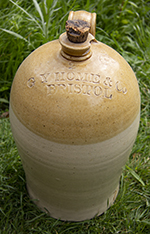
George Young Home was born around 1816 in Stamford Hill, Middlesex, son of George Home, a Scottish merchant and Hannah Muldrup. He married Emily Harriett Godby, daughter of John Hardy Godby, a Royal Navy Captain, in Greenwich, London, on 15 April 1842. The family were living in Scotland until some time after 1851, but were in Long Ashton, South Bristol, by 1853. In 1857 George was in the employ of Cooper's Wine Merchants in Wilder Street. In the 1861 census George is listed as a Wine Merchant and Manufacturer of Pickles. He is living with his wife and eight children at number 1, Forth Villas, Sydenham Hill, Cotham, Bristol. In Harrison, Harrod & Co's 1859 directory, the 1863 Post Office Directory and Webster's 1865 directory he is established at the Asher Lane, Redcross Street factory.
 |
The 1893 publication "The Ports of the Bristol Channel" gives a detailed description of the business and how it came about:
"G. Y. Home & Co., British Wine Makers and Rectifiers, Proprietors of Stivens's Original Green Ginger Wine, and Foreign Wine Merchants, Redcross Street, Bristol. — Originally organised in the year 1841 in Scotland, and subsequently transferred to its present locale, the commercial development of this concern has been so marked that its name has long been familiar as a household word— a gratifying condition of things that is clearly traceable to the high intrinsic merits of its products generally, and notably for the unsurpassed excellence of its specialities, among which "Stivens's Original Green Ginger Wine," and "Home's Lemon Syrup," stand pre-eminent. The first of these, "Stivens's Green Ginger," has enjoyed a long lease of public favour, and has even enjoyed Royal patronage; while the second, by the happy adaptation to domestic use in a new form of the most popular of all fruits, was at once hailed as a boon, and, under the name of "Home's Lemon Syrup," has been recognised ever since as a necessity in every household. With regard to "British Wines," a word of explanation must here be recorded. The title has lately been abused, and mis-applied to liqueurs which are not wines at all, but only mixtures of sugar and water flavoured with essences, &c., avowedly "non-alcoholic" yet audaciously labelled "unfermented wines," a designation which is simply a contradiction in terms. It is almost needless to say that "Home's British Wines" have no affinity to these strange mixtures, but are real "wines," their strength, which is moderate, but sufficient, being chiefly obtained by fermentation, a long and difficult process, requiring skill and judgement in all its stages. Even when the process is concluded, the wines are not complete until after many months careful treatment for the full development of their qualities, and to insure their permanent stability. It is a rare thing for Messrs. Home to allow any wine to go into consumption in less than six months—the average time allowed is from nine to twelve months—but there are much older wines always in stock. Besides "Stivens's" brand, the wine making department yields a variety of other wines, for the production of which the orange, the grape, and the raisin, together with every favourite fruit of the garden and medicinal herb and flower of the field is laid under contribution at the proper season. These are all fermented and make charming and wholesome wines, while the department of "summer beverages," at the head of which stands the original "Concentrated Lemon Syrup," affords scope for the indulgence of the varied tastes and fancies of those who deny themselves the indulgence of any stimulant. In addition to the leading departments there is a special one for the preparation of liqueurs and spirit cordials, and another for the storing and bottling of foreign wines. The premises of the firm, skirting the open space behind Redcross Street, are necessarily extensive. They were rebuilt on a large scale seven years ago (1888), and consist of a three-storeyed building elaborately equipped with all requisites and appurtenances for pressing, racking, storing, maturing, bottling, and finally distributing the produce of the fermenting vats. All this, as may be supposed, gives employment to a numerous staff of operatives, overseers, office clerks, salesmen, and travellers. From the foregoing sketch of the progress of this firm it may be gathered that the success it has achieved is due to the public's recognition of the qualities of perseverance, integrity, and straightforward business methods by which they have always been distinguished."
George died at Ormiston, Beaufort Road,
Clifton, on 25 September 1895, aged 80, however the business continued
until at least 1938.
| 2 Gallon stoneware flagon. |  |
| Impressed:
2 / G Y HOME & Co / BRISTOL Potter: Price + Bristol |